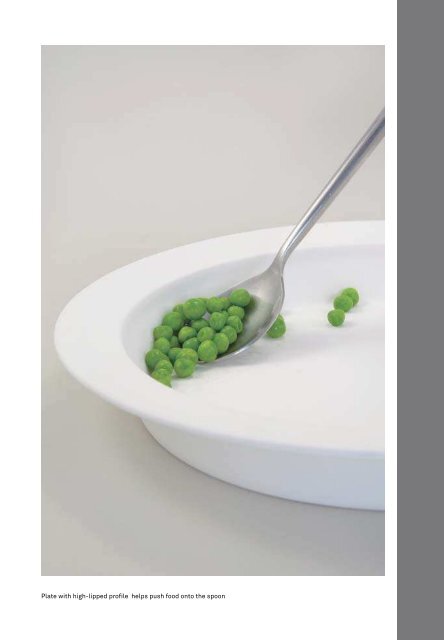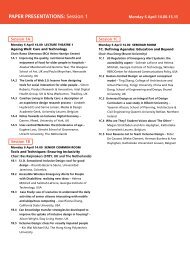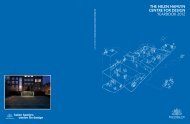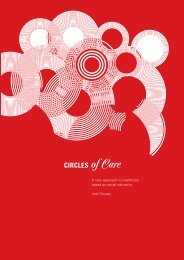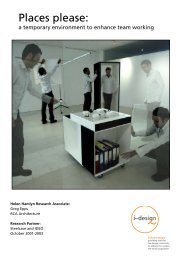Design for Dementia - Helen Hamlyn Centre - Royal College of Art
Design for Dementia - Helen Hamlyn Centre - Royal College of Art
Design for Dementia - Helen Hamlyn Centre - Royal College of Art
Create successful ePaper yourself
Turn your PDF publications into a flip-book with our unique Google optimized e-Paper software.
DINING<br />
REDUCED COMPLEXITY<br />
TABLEWARE TO REDUCE COMPLEXITY<br />
As dementia progresses, some people can<br />
begin to lose their eating skills or find it<br />
increasingly difficult to concentrate on the<br />
task <strong>of</strong> eating. They can become confused<br />
by too many pieces <strong>of</strong> tableware or multiple<br />
items <strong>of</strong> cutlery at their place setting. A<br />
common strategy is to simplify the amount <strong>of</strong><br />
utensils by providing just a plate and spoon<br />
with pureed or diced food that can be eaten<br />
without the need to be cut up by the resident.<br />
This has proved to be very successful as it<br />
simplifies the process <strong>of</strong> eating but still allows<br />
a person to feed themselves.<br />
However, one <strong>of</strong> the difficulties that<br />
emerges from this strategy is that residents,<br />
who are now only using one piece <strong>of</strong> cutlery,<br />
push the food <strong>of</strong>f the side <strong>of</strong> the plate when<br />
they are trying to pick it up. To address this,<br />
the plate contains a high lip in its pr<strong>of</strong>ile that<br />
helps to push the food onto the spoon as a<br />
person tries to scoop it up. It turns the motion<br />
that usually results in food being spilt onto<br />
the table into a way <strong>of</strong> improving eating skills.<br />
The range includes a bowl that is designed<br />
to allow people to pick it up and drink<br />
from it. The rims have been extended to<br />
create a vessel that can easily be held with<br />
two hands. It aims to further reduce the<br />
complexity <strong>of</strong> eating and support people with<br />
limited dexterity.<br />
One <strong>of</strong> the most disliked pieces <strong>of</strong><br />
tableware commonly used in care homes is<br />
a care cup because it is extremely similar in<br />
appearance to a baby cup. This item is given to<br />
residents with reduced dexterity who can then<br />
grip both sides <strong>of</strong> the cup without burning<br />
their hands as they might with a ceramic mug.<br />
The three most problematic features that<br />
rein<strong>for</strong>ce its association with a baby product<br />
include its nippled lid, its two handles and its<br />
construction from plastic.<br />
To challenge this design a cup <strong>for</strong>med from<br />
a single piece <strong>of</strong> ceramic is proposed. The<br />
mould has a double skin with an air-filled<br />
cavity between the inside and outside surfaces<br />
allowing a person to grip the cup without<br />
risk <strong>of</strong> burning themselves. The inner layer is<br />
sloped to reduce the amount <strong>of</strong> movement<br />
that a person’s neck has to make when drinking.<br />
The lid minimises the association to<br />
the nipple <strong>of</strong> a baby cup by elongating the<br />
<strong>for</strong>m around the rim.<br />
Plate with high-lipped pr<strong>of</strong>ile helps push food onto the spoon<br />
55


